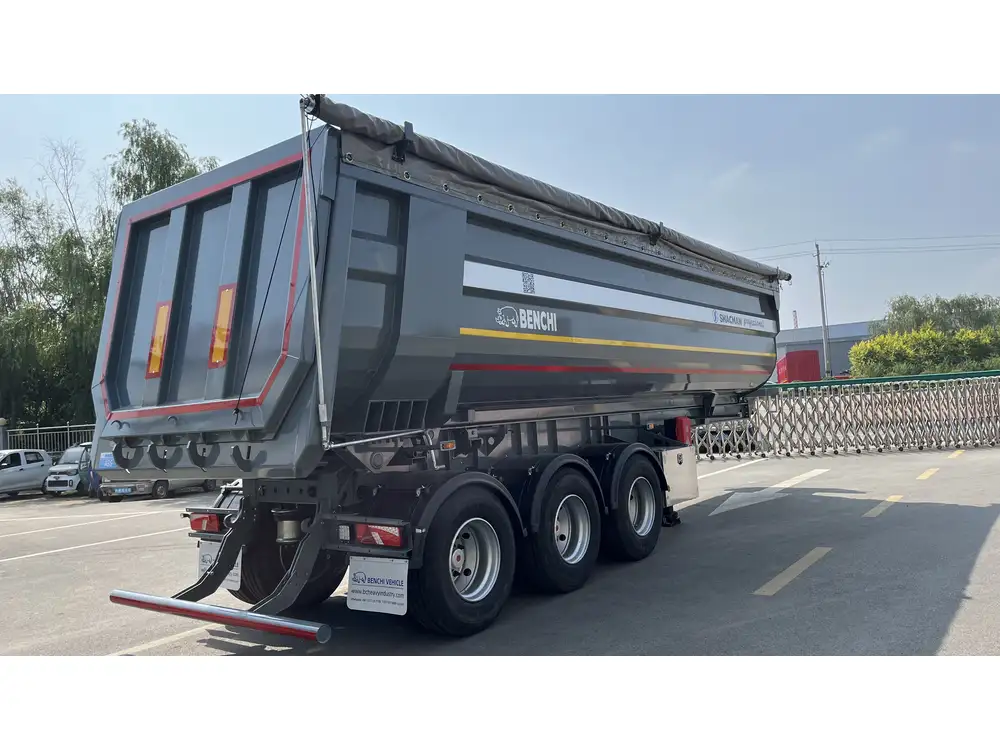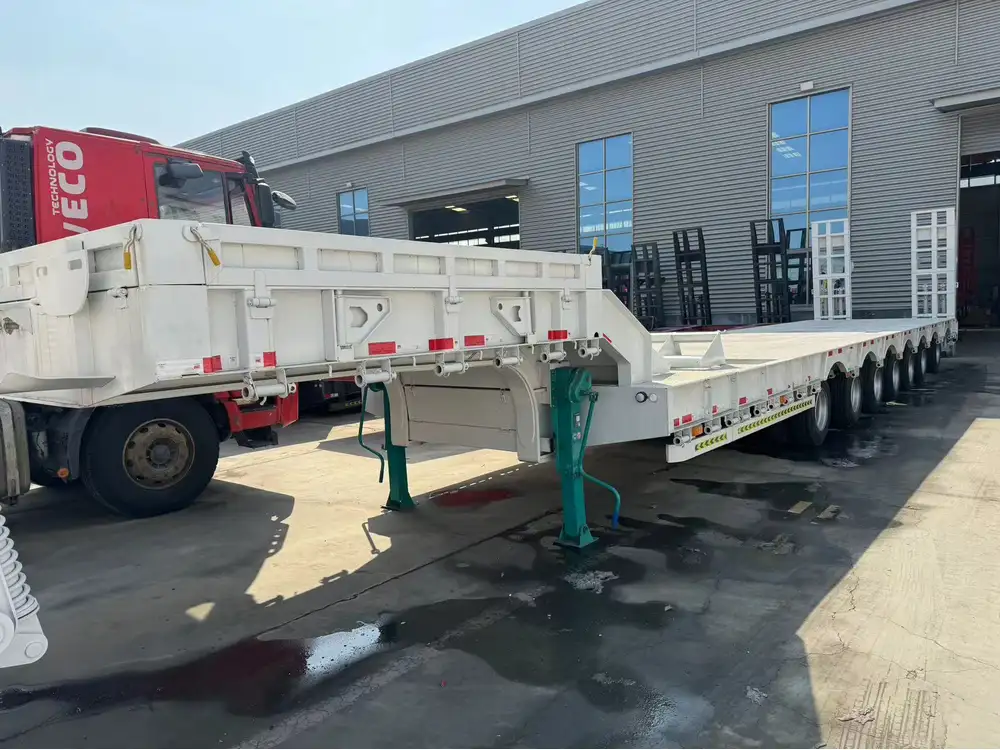The Basics of Semi-Trailer Configuration
The trucking industry hinges on an intricate balance between several vital components—including the vehicle, its load, and the trailer itself. A semi-trailer, characterized by its unique attachment to a tractor unit, is designed to transport various goods across extensive distances. Understanding how much trailer is behind a semi involves analyzing regulatory stipulations, trailer dimensions, and the diverse configurations available in the market today.
What Constitutes a Semi-Trailer?
A semi-trailer is defined as a trailer that is designed to be coupled to a tractor. Unlike traditional trailers, semi-trailers rely on the tractor for support, which means that part of their weight is borne by the tractor unit. Typically, these trailers feature an open rear, enabling them to be fitted using a fifth wheel coupling. This design optimizes load capacity and efficiency.

Dimensions of Semi-Trailers
Standard Lengths
- The most common length for a semi-trailer in the United States is 53 feet; however, there are variations depending on state laws and specific operational needs.
- Other prevalent lengths include 48 feet and sometimes 45 feet, particularly in regional trucking.
Height and Width
- Most semi-trailers have a standard width of 8.5 feet and a maximum height of around 13.5 feet, although these figures can vary based on regulations and operational requirements.
Total Length Restrictions
- Federal regulations stipulate a maximum overall vehicle length of 75 feet for a tractor-trailer combination, including the tractor and semi-trailer. However, variations may exist in different states or jurisdictions.
Regulations Governing Trailer Lengths
In understanding how much trailer is behind a semi, one must factor in the regulations governing trailer lengths in different jurisdictions:
| Region | Maximum Length (Feet) | Notes |
|---|---|---|
| United States (Federal) | 75 | Combination of truck + trailer |
| California | 65 | Includes specific restrictions on axle counts |
| Canada | 53 | Standard for most provinces |
| Europe | 16.5 | Standard for length overall for tractor units |
How to Measure Trailer Lengths
When we consider how much trailer is behind a semi, measuring the trailer’s length accurately is imperative. Follow these steps:
- Identify the Coupling Point: Locate where the semi-trailer connects to the tractor.
- Measure from the Nose: Use a measuring tape to determine the length from the front to the back of the trailer, stopping at the nearest point of the trailer’s end.
- Consider Load Variations: Different loading configurations can momentarily affect length, especially in extendable flatbeds.

The Importance of Knowing Trailer Length
Understanding how much trailer is behind a semi tells us more than just measurements; it serves crucial operational purposes. Here are a few reasons why this knowledge is essential:
1. Road Safety and Regulations Compliance
Knowing the dimensions of your semi-trailer is fundamental in ensuring compliance with road safety regulations. Overloaded or oversized trailers pose risks to the driver and other road users. Failing to adhere to prescribed limits can lead to fines, penalties, and even accidents.
2. Efficient Route Planning
Certain roads and bridges have restrictions based on vehicle lengths. Familiarity with your semi-trailer’s dimensions allows for effective route planning and ensures the driver can avoid potential hazards. Choosing the appropriate paths helps minimize delays and enhances delivery efficiency.

3. Fleet Management Considerations
For fleet managers, understanding the lengths of different semi-trailers is essential in asset management. Some loads may require specific trailer sizes and configurations, so this knowledge aids in optimizing the fleet’s overall utility and performance. Fleet efficiency translates into better resource allocation and cost savings.
Common Semi-Trailer Configurations
When discussing how much trailer is behind a semi, it is critical to analyze common semi-trailer configurations, as each serves unique purposes suitable for varying cargo types.
1. Flatbed Trailers
- Description: These trailers have no sides or roof and allow for easy loading from all angles, making them perfect for oversized or irregularly shaped loads.
- Typical Length: Flatbeds can range from 48 to 53 feet.
- Usage: Ideal for transporting construction materials, heavy machinery, etc.

2. Dry Van Trailers
- Description: Contained and enclosed, these trailers are designed for roadway freight transport, protecting cargo from environmental factors.
- Typical Length: Generally 53 feet.
- Usage: Perfect for palleted goods, electronics, and paper products.
3. Refrigerated Trailers (Reefers)
- Description: Equipped with temperature control systems, these trailers maintain a specific temperature for sensitive loads.
- Typical Length: Typically 53 feet.
- Usage: Essential for food transportation and pharmaceutical products.
4. Tank Trailers
- Description: Designed for transporting liquids, including hazardous materials, these trailers feature cylindrical tanks mounted to a flatbed.
- Typical Length: Varies, typically between 40 and 50 feet.
- Usage: Commonly used for delivery of fuels, chemicals, and water.

5. Lowboy Trailers
- Description: With a low profile, lowboy trailers facilitate the transportation of heavy equipment, providing stability and safety while hauling oversized items.
- Typical Length: Generally between 20 to 38 feet.
- Usage: Ideal for heavy machinery, construction equipment.
Factors Affecting Trailer Length Needs
Determining how much trailer is behind a semi is not solely driven by regulations or standard measurements; it is influenced by various operational and cargo-related factors:
Load Type and Weight
- Specific cargo types may dictate the use of longer or specialized trailers.
Operational Routes
- Short hauls versus long-haul logistics may demand different trailer lengths.
Regulatory Changes
- Staying updated with the latest federal and state transportation laws is imperative.
Choosing the Right Trailer Length
In light of the diverse requirements across sectors:
- Evaluate Cargo Volume: Identify cubic capacity needs.
- Analyze Loading Mechanisms: Consider how and where loads will be loaded and unloaded.
- Consult Industry Standards: Regulatory compliance should never be compromised.
- Consider Seasonal Fluctuations: Adapt your trailer lengths according to peak seasons or trends in your goods transport.

Further Implications: Future Trends in Semi-Trailer Lengths
Exploring how much trailer is behind a semi opens a gateway to future trends in trailer configurations and dimensions. As the industry advances, several key factors will shape these developments:
1. E-commerce Growth
As online shopping flourishes, expedited shipping demands may encourage the adoption of longer trailers for efficiency, affecting conventional dimensions.
2. Sustainability Efforts
Environmental considerations will push for innovations in trailer design, optimizing length while minimizing weight to improve fuel efficiency.

3. Technological Advancements
Smart trucking technologies introducing enhanced navigation and load tracking systems could contribute to a migration towards versatile trailer designs that adapt to varying lengths as dictated by cargo.
4. Policy and Legislative Influence
Continual assessment and potential adjustment of federal and state weight limits and overall vehicle lengths can profoundly affect what configurations are used in the industry.
Conclusion: The Significance of Understanding Semi-Trailer Lengths
In summary, grasping how much trailer is behind a semi goes beyond mere measurement—it involves a comprehensive understanding of regulations, configurations, and operational requirements. This addresses critical considerations in road safety, route planning, and efficiency optimization within fleet management. As we look to the future, the industry’s adaptive nature demands continuous reevaluation of semi-trailer lengths in response to evolving marketplace dynamics. By staying informed, we can navigate the complexities of trailer logistics and positioning ourselves for success in the transportation sector.
By understanding and leveraging these insights, stakeholders can ensure compliance, enhance operational efficiency, and navigate the intricate landscape of transportation logistics with greater ease and effectiveness.



